January - March Quarter 2021 Data Update - RAC:ASX
Jan- March Quarter 2021 Summary.pdfIn an effort to keep existing and new RAC holders informed, I have decided to begin creating a quarterly update of the company, the share price movements, bisantrene, and scientific evidence underpinning FTO. Currently, there have been 29 articles relating to FTO released since the start of the year. Understanding what this new evidence means in the context of our investment is fundamental to maintaining conviction and appreciating the opportunity FTO offers to RAC shareholders. The information provided in this document is from my best understanding and knowledge and does not constitute financial advice - my interpretation of the science may be wrong or misleading.
1. RAC
Key announcements for RAC include:

2. Share Price

2.1 Short-term
2.1.1 Share Price Estimation
Based on price movements over the last 12-months, I estimate that RAC will achieve a share price of $7.36 between May 4th to June 17th 2021 (figure below). Notably, since the discovery of bisantrene as a potent FTO inhibitor, share price increases for each new high have been 96% and 85%, time to reach a new high has reduced from 20 weeks to 14 weeks, and time spent in neutral MACD territory has reduced from 8 weeks to 3 weeks. Based on this information, I estimate that a new all time high 74% greater than the most recent $4.23 peak will be reached 8-14 weeks after that peak (9th of March).
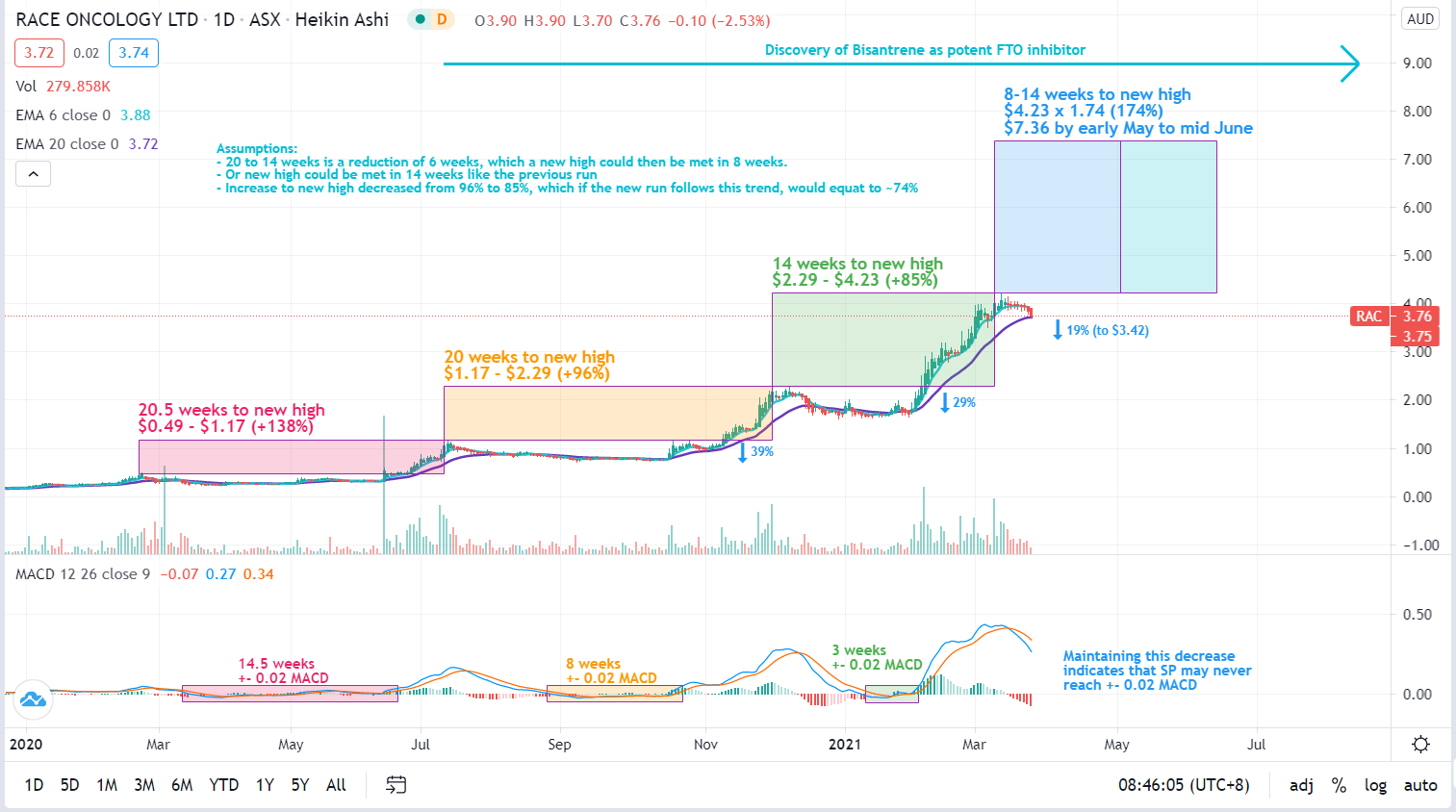
2.1.2 Strategic update and key price catalysts
Based on the information that we have available we can expect the following in Q2 2021:
- Preclinical FTO breast results (speculative)
- Preclinical FTO ovarian results (speculative)
- Final contract signing and initiation of AUS PII Metastatic BC trial
- Detailed, costed proposal from George Clinical for Eastern EU PIIb Trial for metastatic BC demonstrating heart safety
- Outcomes of preclinical heart safety discussions
- Trial contract details signed and first patient dosed for Israel PI/II R/R AML trial
- Potentially evaluated Children's Oncology Group trial proposal
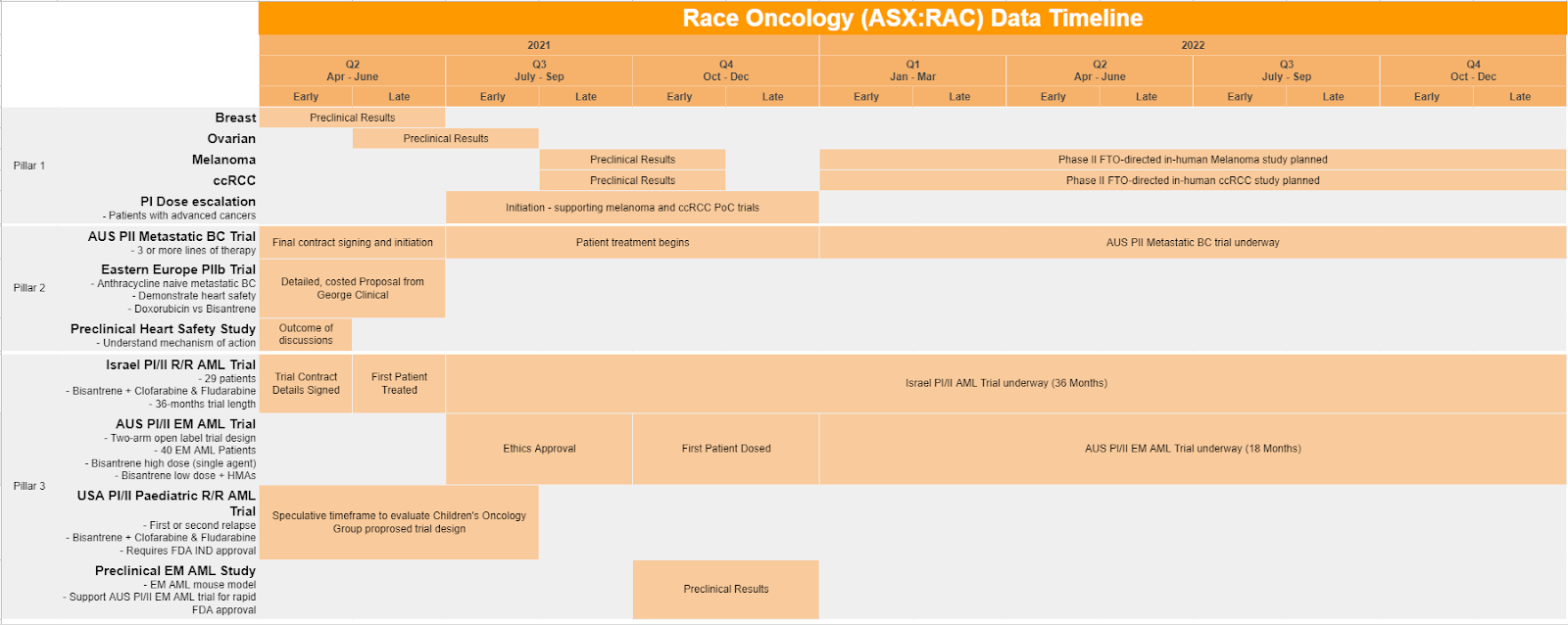
2.2 Long-term Share Price Observations
This chart was completed by @wombat777 (Hotcopper handle). Here is a link that pertains to extra information necessary to understanding what it means and where we are going here: https://hotcopper.com.au/threads/prediction-rac-will-have-legendary-unicorn-like-status-among-drug-development-biotechs.5934872/?post_id=51380459
Briefly, RAC has honoured this long-term log chart trend for the last 22-months. Key events are detailed down the bottom along the chart that could lead to a merger and acquisition (M&A) transaction. It is expected to continue honouring this trend as long as RAC management, of whom I have high respect for, can execute the strategy.
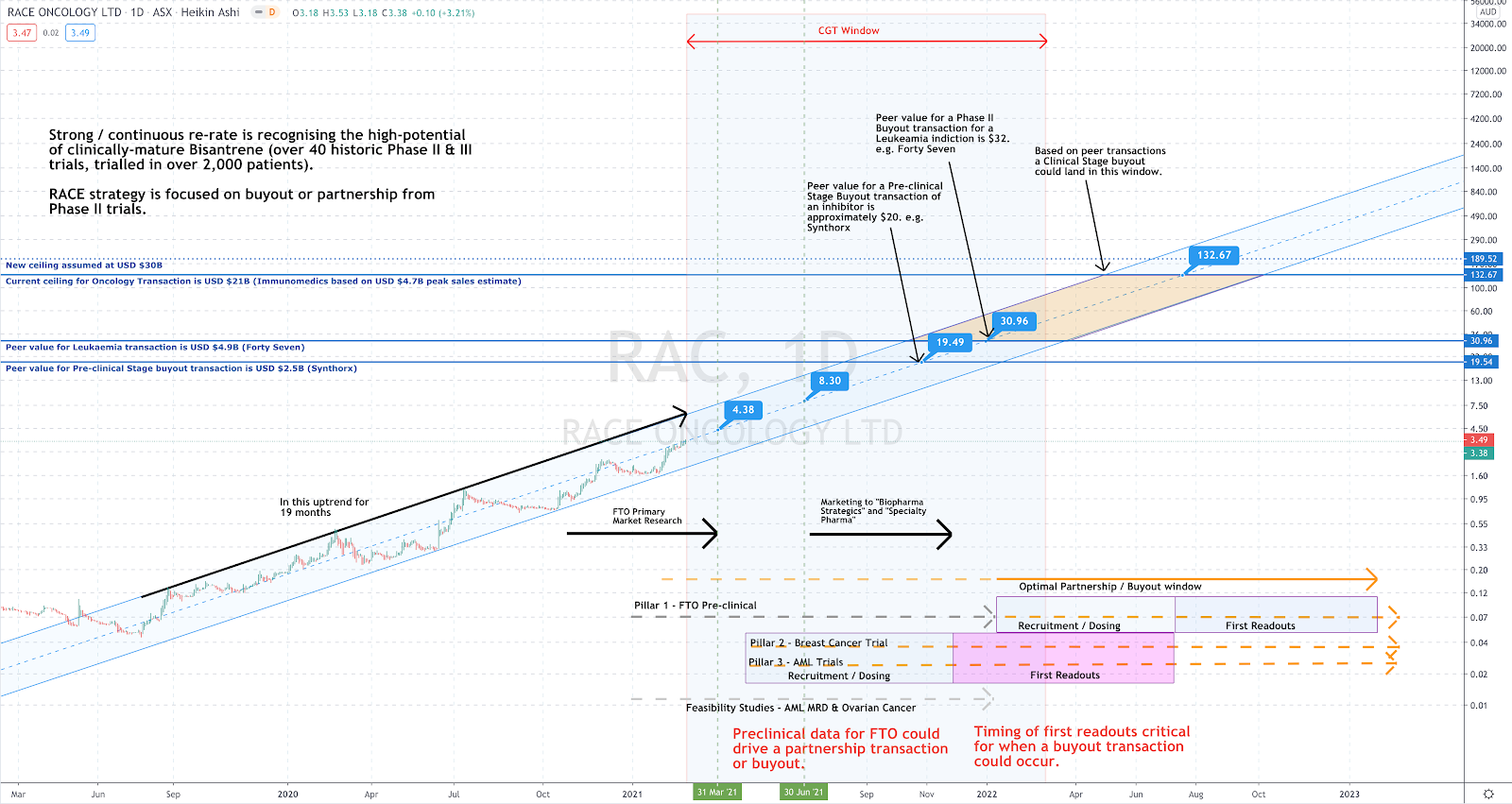
3. Bisantrene Data
There have been three studies released that evaluated the clinical efficacy of bisantrene:
3.1 Preclinical Breast Cancer
Bisantrene killed breast cancer cells resistant to the current standard of care breast cancer drugs etoposide, palbocicclib, fulvestrant, tamoxifen, doxorubicin, epirubicin and cyclophosphamide
Bisantrene was found to kill breast cancer cells from all common breast cancer subtypes including triple negative, ER+, and Her2+
These results clearly support advancing Bisantrene into human breast cancer clinical trials
The MCF-7 cell lines included in this study are known to overexpress FTO. In the MCF-7 cell lines resistant to breast cancer drugs, bisantrene was up to 5x more effective than doxorubicin and epirubicin. Also, MCF-7 cells selected for resistance to palbocicclib, fulvestrant and tamoxifen, were 1.4-fold, 1.6-fold and 2.8-fold more sensitive to Bisantrene than the parental MCF-7 cells, respectively. It is my belief that the FTO mechanism influenced the relationship observed in MCF-7. Although, the multidrug resistant protein 1 is mentioned for the MCF-7/VP16 breast cancer cell lines. If the FTO mechanism is not involved in these breast cancer cell lines, then another unknown or known mechanism may be influencing the findings. The findings highlight the role of Bisantrene as a salvage treatment. Used in combination with cyclophosphamide, bisantrene acts very similarly to doxorubicin and epirubicin.
https://newswire.iguana2.com/af5f4d73c1a54a33/rac.asx/6A1023631/RAC_Compelling_Preclinical_Breast_Cancer_Results
3.2 Ovarian Cancer:
Bisantrene found to be more effective compared to doxorubicin and epirubicin in ovarian cancer cell lines
Bisantrene killed ovarian cancer cells resistant to the current standard of care chemotherapeutic agents cisplatin, 5-fluorouracil and chlorambucil
These preclinical results are encouraging and consistent with past Phase II clinical trials which identified Bisantrene as an effective ovarian cancer treatment.
https://newswire.iguana2.com/af5f4d73c1a54a33/rac.asx/6A1021436/RAC_Positive_Early_Preclinical_Ovarian_Cancer_Results
3.3 City of Hope Paper #2:
Bisantrene drastically reduced glycolytic rates in NOMO-1 cells without significantly altering mitochondrial respiration at low nanomolar concentration (200 nM), implying the potential of pharmacologically targeting FTO to manipulate cancer cell metabolism for leukemia therapy (figure below).
Bisantrene at a low concentration is sufficient to effectively attenuate glycolytic flux in leukemia cells, adding a new layer of mechanism for the anti-tumor activity of FTO inhibitors.
The figure below shows that bisantrene significantly reduced glycolysis in NOMO-1 leukemia cells. The key things to look for in this figure is the red line compared to the black line from minutes 0 to 40 on the left hand side and then the red box compared to the black box on the right hand side. The three *** indicates that the difference is significant, which highlights the potency of bisantrene in this mechanism of action.

https://pubmed.ncbi.nlm.nih.gov/33434505/
Implications:
This new discovery is massive for bisantrene, as it unveils a new mechanism of action for the FTO inhibitor. It is important to understand that aerobic glycolysis is a hallmark feature of cancer cells and thus, finding a mechanism that inhibits this process is profound. A recent review paper (2020) discusses the competition between cancer cells and T cells (cancer killing cells) for energy via glucose and glycolysis.
The cancer cell and the T cell (cancer killing cells) compete for the same nutrient (glucose) and if the cancer cells win, then the T cells do not have energy to function
The increase in glycolytic flux produces immunosuppressive metabolites like lactate, which reduce tumor immune rejection and responses to immunotherapy
Therefore, inhibiting FTO decreases cancer cells ability to produce energy and produce metabolites that improve its ability to avoid the immune system and death; highlighting the significance of the new discovery.
https://www.nature.com/articles/s41419-020-03175-5.pdf
4. Potential drug synergies
Firstly, and arguably the most exciting, are papers that suggest FTO inhibition could improve the efficacy of proton pump inhibitors (1), androgen receptor binding inhibitors (2), and phosphoinositide 3‐kinase (PI3K)‐targeted therapies (3). Based on the research that I have done, that brings the total potential synergies to eight (Table 1).
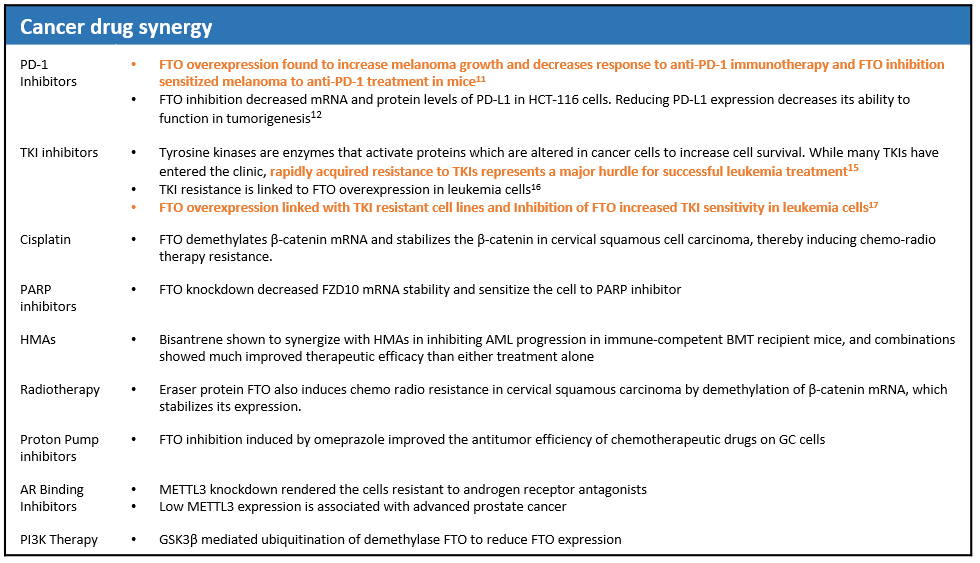
https://www.biorxiv.org/content/10.1101/2021.01.12.426354v1.full.pdf
https://portlandpress.com/bioscirep/article/41/1/BSR20200842/227460/Omeprazole-improves-chemosensitivity-of-gastric
https://onlinelibrary.wiley.com/doi/full/10.1111/jcmm.16291
5. Small molecule FTO inhibitors
There have been three publications since the turn of the year that have mentioned new, small molecule FTO inhibitors, which include FTO-04, SYG00001666, and compounds 2 and 3. For a drug to be an effective FTO inhibitor, it is required to have an IC50 value in the nM range - this implicates that the drug is potent at low concentrations and is highly selective of the FTO molecule. The common theme across the new FTO inhibitors developed are that they have relatively high IC50 values when compared to bisantrene (bisantrene is in the nM range whereas other drugs are in the uM range; e.g. 1000 times larger). Also, since bisantrene has historic phase I, II, and III data, it has an enormous amount of safety and tolerability data available which indicates that it is clinically ready to be used and tested in humans for FTO inhibition; this saves time and money, which is another strike against the newly discovered/developed FTO inhibitors.
Of all the FTO inhibitors identified below, brequinar (CS1) has the right IC50 value, although recent evidence shows that it has failed clinically as an anticancer agent and transplant organ rejection drug, is immunosuppressive, and plasma concentrations of the drug vary patient to patient.

https://pubs.acs.org/doi/10.1021/acschembio.0c00841
https://www.sygnaturediscovery.com/wp-content/uploads/2019/08/FTO-Poster.pdf
https://www.biorxiv.org/content/biorxiv/early/2021/02/24/2021.02.23.432419.full.pdf
6. Association between FTO and cancer
While I have commented on one paper that linked FTO expression to bladder cancer (1), there was another paper that confirmed these findings released in January 2021 (2). The study found that FTO decreased m6A levels in PYCR1 cells which promoted bladder cancer initiation and progression. Also, the FTO protein was negatively associated with overall survival in bladder cancer patients. Importantly, prior to January 2021, it was thought that FTO was down-regulated in bladder cancer (3). Taken together, these articles highlight the relationship between FTO overexpression and bladder cancer, while also providing reasonable evidence to encourage pharmaceutical interventions that may attenuate rising FTO concentrations to improve bladder cancer patient outcomes.
Cumulatively, this increases the number of total cancers influenced by FTO, with cancers highlighted in orange as a focus for RAC in the coming months:
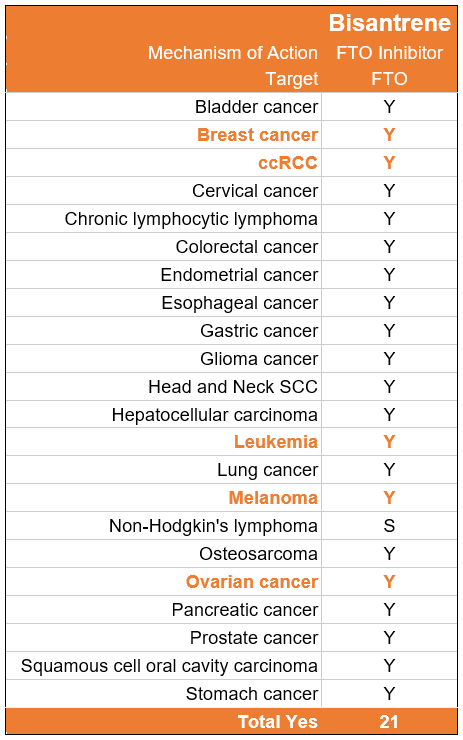
In January and February 2021, there were two reviews for the role of FTO in breast cancer and gastrointestinal cancer (GIC) (4,5). The role FTO overexpression plays in breast cancer, describing how m6A demethylases affects breast cancer cells via different molecules and signaling pathways, how m6a demethylase exhibits abnormal expression in breast cancer tissues and is related to certain breast cancer subtypes, and relating breast cancer prognosis to the atypical expression of m6A demethylase (4). In GIC, the paper explored the role of FTO in RNA methyladenosine modifications in gene expression and the resulting tumorigenesis, cancer progression, and drug resistance, highlighting the potential therapeutic regimens for GICs (5). More research has discussed FTO overexpression in multiple different cancer types with multiple genetic targets which causes changes to behaviour of tumor cells including cell proliferation, migration, chemo-radiotherapy resistance, metastasis, colony formation, and survival (6). FTO was further linked with myeloblast proliferation, Gefitinib (tyrosine kinase inhibitor) sensitivity and efficacy, and gastric cancer (7-9). Papers that were not as specifically directed towards FTO had identified and linked the m6A mechanism to chemoresistance of cisplatin in ovarian cancer (10) as well as downregulation of the other m6A demethylase linked to uveal melanoma (11).
In March 2021, a lung cancer review paper summarised the role of FTO and FTO knockdown in non-small cell lung cancer and lung adenocarcinomas (12) while other papers furthered the understanding of FTO and liver cancer (13). Without going into too much detail, other research highlighted the role of the mRNA mechanism in macrophage reprogramming (something cancer cells do to help them survive) (14) and expression and function of T cells (cells that kill cancer) (15).
https://onlinelibrary.wiley.com/doi/pdf/10.1002/ctm2.310
https://www.aging-us.com/article/202359/pdf
https://www.ncbi.nlm.nih.gov/pmc/articles/PMC7751723/pdf/ott-13-12845.pdf
https://www.frontiersin.org/articles/10.3389/fcell.2020.615071/full
https://www.frontiersin.org/articles/10.3389/fonc.2020.586789/full
https://www.frontiersin.org/articles/10.3389/fonc.2020.623634/full
https://www.sciencedirect.com/science/article/abs/pii/S0014482721000550
https://mcr.aacrjournals.org/content/early/2021/02/09/1541-7786.MCR-20-0541
https://www.researchgate.net/publication/342883862_HDAC3-dependent_transcriptional_repression_of_FOXA2_regulates_FTOm6AMYC_signaling_to_contribute_to_the_development_of_gastric_cancer
https://www.sciencedirect.com/science/article/abs/pii/S0167488920302366?via%3Dihub
https://www.aging-us.com/article/202371/text
https://www.mdpi.com/2073-4425/12/3/440
https://www.dovepress.com/gene-expression-profile-and-prognostic-value-of-m6a-rna-methylation-re-peer-reviewed-fulltext-article-JHC
https://www.nature.com/articles/s41467-021-21514-8
https://www.frontiersin.org/articles/10.3389/fimmu.2021.641507/full
7.Mutant-RAS Cancer and FTO
This paper explored the relationship between m6A methylation and initiation pausing (1). Importantly, mutant-RAS type cancers are present in 26 different cancer types and studies show that 16% of those cancers will have mutated RAS components (Figure below; 2). Reduced m6A methylation (FTO overexpression) led to relaxed initiation pausing, which promoted malignant transformation and tumor growth. Also, the study found that initiation pausing could be restored by inhibiting m6A demethylases, which suppresses RAS-mediated oncogenic translation and subsequent tumorigenesis. This study highlights not only a mechanistic pathway of FTO in tumorigenesis, but a key therapeutic opportunity for a potent FTO inhibitor.

https://advances.sciencemag.org/content/7/8/eabd6927
https://www.ncbi.nlm.nih.gov/pmc/articles/PMC3354961/
8. FTO and Heart Failure
A study in March 2021 found that FTO was overexpressed in peripheral blood of heart failure preserved ejection fraction (HFpEF) patients and that FTO overexpressed in heart tissue of HFpEF mice (1). Importantly, HFpEF is the most common type of heart failure, accounting for 50% or more of cases. While caution is encouraged when making inferences, this study may provide some insight as to why bisantrene offers a safer cardiac profile to other anthracycline-based therapies. Further studies are needed to determine whether FTO inhibition in these groups confers any benefit.
1. https://www.frontiersin.org/articles/10.3389/fcvm.2021.647806/full
Conclusion
In summary, the understanding of the relationship between FTO and cancer is an ever growing body of research. Notably, FTO overexpression has now been linked with bladder cancer, mutant-RAC cancer types, chemoresistance, new potential cancer drug synergies, and most importantly cancer cell glycolysis. While multiple papers are searching for small molecule inhibitors of FTO, they lack in areas that would make them effective in the clinic relative to bisantrene. Thus, highlighting the therapeutic role a potent FTO inhibitor, like BIsantrene, could play in the cancer therapy landscape.
Reference tables for January, February, and March:



 (20min delay)
(20min delay)









